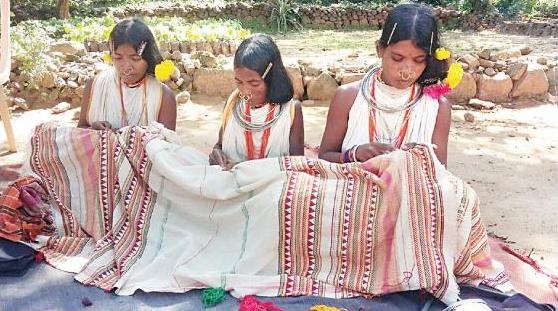Bhawanipatna: After Odisha has won the ownership right of Rasagolla, now Kalahandi and Rayagada people and administration are demanding GI tag to ‘Kapdagonda Shawl’ of Dongarias.
Kapdagonda shawls embody the rich heritage of Dongria Kondh tribes of Niyamgiri. The shawls have a special demand within our country and in the international market as they present the tradition and culture of the tribal community. The weaving of shawls also provides a livelihood for the disadvantaged community.
However, the Kapdagonda Shawl is in huge demand among domestic and international tourists for its geometric patterns.
It seems that the Dongria Kondhs, a particularly vulnerable tribal group (PVTG) who live in the Niyamgiri Hills of Rayagada and Kalahandi districts in southern parts of Odisha, now have to fight for their ethnic embroidered Kapdagonda Shawl, which is being replicated by some designers for the past few years.
As per the 2011 Census, more than 7,000 Dongarias are living in the district. They have been weaving shawls for more than a hundred years.
The Dongarias are still using their traditional handmade clothes even though they have been introduced to modernity.
The Dongarias named the shawl ‘Kapdagonda’ in their Kui language. They weave three types of shawls — Kapdagonda, Sialiganda and Ullindiganda. They use these three types of shawls to cover different parts of their body.
But from among all types of shawls the Kapdagonda has created more demand in the national and international market.
The off-white coarse cloth mainly used as a raw material for Kapdagonda is procured from Dombs, a local Scheduled Caste community, by bartering harvested crops. The motifs are embroidered on the cloth by a needle using three different colour threads — green, yellow and red. Each colour carries an implication manifested with socio-cultural values.
Green symbolizes their fertile mountains and hills, prosperity and development of their community; w yellow stands for peace, smile, togetherness, health and happiness and a sign of auspiciousness; red is the symbol of blood, energy, power and revenge. It also signifies appeasing of deities by offering blood of animals and birds as sacrifice.
The hand-woven motifs in the shawl are mainly different types of lines and triangular shapes that reflect the importance of mountains for the community. The triangular shape of mountains recurs in the designs painted on the walls of the village shrine as well as in the colourful Kapdagonda they wear.
To prevent duplication, the district administration has decided to create a national market for the product in collaboration with the handlooms department. The initiative seeks to ensure that originality is maintained and no machines are used in preparing it.
“Seeing the popularity of its patterns and motifs, efforts will be made to replicate the designs of Kapdagonda on bags, mobile phone covers and conference pads,” said an officer of the district administration. The district administration has recently launched a three-month-long programme called Ama parampara ama jeevika (our tradition, our livelihood) to train more weavers in traditional craft of Kapdagonda.
To prevent duplication and imitation and enhance the socio-economic condition of the Dongarias, the state government should make efforts for getting GI tag to the Kapdagonda Shawl.
Both Kalahandi and Rayagada district administrations have been pressing for GI tag to the Dongaria Shawl since 2018. But either the state government or the Central government has not paid heed to the administrations’ pleas.
All the documents related to GI tag to Dongaria shawls remain wrapped in the files of government office.
Rayagada Collector Pramod Kumar Behera has sent a letter again to Handicrafts and Handlooms Department’s director concerning GI tag to Kapdagonda Shawl.
Locals said, if the state government gets a GI tag for the ethnic shawl, the designs will not be replicated.
PNN






































